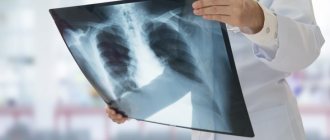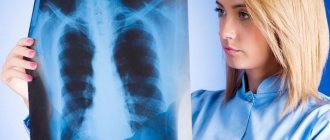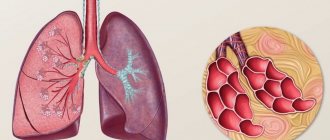Pneumonia can be suspected by its characteristic symptoms - high body temperature combined with a severe cough. However, this is not always the case. In some cases, the temperature does not rise, but the person continues to cough. This can confuse the patient and he puts off visiting the doctor. As a result, valuable time is lost. When contacting the Yusupov Hospital, the patient is immediately prescribed an examination, thanks to which it is possible to accurately diagnose and begin treatment on time.
Causes of pneumonia
Almost always, an inflammatory reaction in the lung tissue is caused by an infection. Pneumonia can be caused by many microorganisms - bacteria (most often), viruses, fungi and even some types of protozoa. In the vast majority of cases, the cause of pneumonia is:
- streptococcus pneumoniae - pneumococcus;
- chlamydia;
- haemophilus influenzae - hemophilus influenzae;
- respiratory syncytial virus is the most common cause of viral pneumonia
- other types of streptococci;
- staphylococci;
- mycoplasma.
Sometimes pneumonia can also be non-infectious and be caused by:
- toxic lesions of lung tissue;
- allergic reactions;
- autoimmune diseases;
- exposure to extreme temperatures;
- penetrating radiation (cancer patients undergoing radiation therapy to the lungs).
SOS: danger of contracting pneumonia
The disease is transmitted by airborne droplets, especially if the body is weakened and immunity is low. The causative agents can be staphylococcus, Escherichia coli, streptococcus, Haemophilus influenzae. It develops if improper treatment is prescribed for bronchitis or influenza, as well as any other respiratory disease, including common acute respiratory infections.
Recently, the disease has adapted and does not always make itself felt immediately. Often the symptom is simply general fatigue and drowsiness, as well as chest pain without the characteristic cough and fever.
It is necessary to understand that even with such a diagnosis, hospitalization is mandatory. Treating pneumonia at home will lead to more serious complications. In addition, the disease is contagious and, while at home, the patient poses a threat to others.
It is important to understand that it is not so much the disease that is dangerous, but the consequences of pneumonia. Therefore, the main thing is not to start and stop the course of its development in time.
In worst cases, it will lead to gangrene or pulmonary edema, sepsis, meningitis, and abscess. In the most difficult cases, the patient faces death without treatment.
Risk factors
Predisposing factors for the occurrence of inflammation in the lung tissue are:
- chronic diseases of the endocrine, cardiovascular and respiratory systems;
- disturbances in the functioning of the immune system;
- bad habits (primarily smoking);
- malformations of the respiratory system;
- sedentary lifestyle.
Severe cases of the disease occur especially often in older people over the age of 65. Pneumonia is also extremely dangerous in newborns and children of primary school age. It is these categories of patients that account for the vast majority of deaths.
Symptoms of pneumonia in children
In early childhood, the course of development of pneumonia is different. Type of treatment too. It occurs not only due to hypothermia of the body, but also due to developmental defects, foreign objects entering the respiratory tract, and frequent aspiration during regurgitation. It is worth contacting a specialist when you notice signs such as:
- increased fatigue in a child;
- drowsiness and apathy;
- lack of appetite;
- rapid breathing;
- causeless frequent crying.
At the age of seven years and older, the symptoms of pneumonia are similar to adults and are characterized by high fever, weakness, and heavy sweating.
Types of pneumonia
According to the prevalence of the process, pneumonia can be:
- focal, affecting only a small area;
- segmental, spreading to one or more segments of the lung;
- lobar, occupying the entire lobe of the lung;
- total, with damage to the entire lung.
The disease is classified according to its causes:
- bacterial pneumonia;
- viral pneumonia;
- mycopneumonia;
- mixed types, in which massive infection with various microorganisms leads to inflammation of the lung tissue.
In addition, there are unilateral (affecting one lung) and bilateral pneumonia (affecting both lungs). Based on the duration of the course, there are acute forms, lasting up to 3 weeks, and subacute forms, lasting from 3 to 6 weeks. Finally, depending on the severity of symptoms, pneumonia can be mild, moderate, or severe, and may or may not have complications (primarily heart and/or respiratory failure).
Symptoms in bedridden patients
Bedridden patients are at increased risk because their immunity is reduced and sputum discharge is difficult. Very often, it is these patients who develop a latent form of the disease, in which not only hyperthermia, but also a cough is absent.
Impaired lung function, stagnation of sputum, limited mobility, stasis of blood in the vessels - all this is fertile ground for the proliferation of microbial flora.
To identify the disease in time, you need to pay attention to the following symptoms:
- The appearance of an unusual blush on the cheeks.
- Increased sweating, which leads to the need to change clothes more often.
- Refusal to eat, but increased need for fluid.
- Indifference to the surrounding world.
If you notice such symptoms, you must inform your doctor.
Signs of pneumonia
The standard clinical picture of pneumonia is characterized by symptoms:
- Sudden onset.
- A sharp rise in body temperature above 38 0C.
- Rapid onset of cough with sputum production.
This is how almost all bacterial and viral pneumonias begin, including the most common variants caused by pneumococcus. As the disease progresses, the symptoms include shortness of breath and painful, often stabbing, sensations in the chest. Such symptoms can persist in the patient for up to 2 weeks.
The modern clinical picture of community-acquired pneumonia can vary widely and be “erased” due to the uncontrolled use of antibacterial drugs. Has symptoms of respiratory infections:
- your health will deteriorate over several days;
- dry cough with virtually no phlegm;
- headache;
- increased weakness and fatigue;
- muscle soreness;
- pain and sore throat.
Symptoms of coronavirus COVID-19
Coronavirus
COVID-19
14067 January 27
IMPORTANT!
The information in this section cannot be used for self-diagnosis and self-treatment. In case of pain or other exacerbation of the disease, diagnostic tests should be prescribed only by the attending physician. To make a diagnosis and properly prescribe treatment, you should contact your doctor. Definition
The SARS-CoV-2 virus spreads in microscopic particles of fluid released by a sick person during coughing, sneezing, talking, singing or heavy breathing and gets onto the mucous membranes of the nose, mouth or eyes of another person.
In addition, the virus can also spread through household contact, when particles with the virus located on surfaces or objects enter the mucous membranes of the respiratory tract through the hands.
Aerosol transmission occurs in closed, crowded and poorly ventilated areas.
The airborne dust (aerosol) transmission route is realized through the spread of aerosols (droplet nuclei) suspended in the air, the size of which is <5 microns. Due to their small size, aerosols can be transported over long distances and remain in the air for several hours. It must be remembered that aerosol-producing devices (nebulizers, halochambers, etc.) are prohibited for use in healthcare institutions during the COVID-19 pandemic.
Symptoms of mild COVID-19
Most common symptoms
- The main symptom (80-90%) is any increase in body temperature (even low-grade - 37-37.5°C).
- The cough is dry or with a small amount of sputum (60-80%).
- Increased fatigue (40-50%).
Less common symptoms
- Sudden loss of smell and/or taste (60-80%).
- Nasal congestion or mild rhinorrhea (5%).
- Conjunctivitis or redness of the eyes (1-2%).
- Sore throat (14%).
- Headaches, dizziness (8-14%). Immediately after the end of the incubation period, migraines of varying severity may appear.
- Pain in joints and muscles (11-15%).
- Skin rashes (8%).
- Diarrhea, nausea, vomiting (up to 20%).
- Chills (11-13%).
Those who have had a mild form of COVID-19 infection compare the sensations with the course of a common respiratory disease.
Symptoms of COVID-19 in severe and moderate forms of the disease
Most common symptoms
- Shortness of breath, rapid breathing (55%).
- Increased cough, appearance of sputum (30-35%).
- Hemoptysis (5%).
- Loss of appetite (20%).
- Confusion (9%).
- Sensation of constriction and congestion in the chest (> 20%).
- Body temperature above 38°C (80%) for more than 5 days.
- Blood oxygen saturation according to pulse oximetry (SpO2) ≤ 95% (up to 20%).
Less common symptoms
- tachycardia,
- vitamin D deficiency,
- irritability,
- convulsions,
- anxiety,
- depressed state
- sleep disorders.
Important! Symptoms may not be detected during the incubation period of COVID-19 or may appear in any combination (for example, without fever). The exact diagnosis is determined by the doctor based on the results of examinations.
Patients over 65 years of age may experience an atypical picture of the disease, which includes delirium (cloudedness of consciousness), speech impairment, movement disorders, as well as more severe and rare neurological complications - stroke, inflammatory brain damage, and others.
The majority (about 80%) of patients who develop symptoms recover without hospitalization. Approximately 15% of patients develop a severe form of the disease that requires oxygen therapy, and 5% develop an extremely severe form that requires treatment in an intensive care unit.
Differences between the new coronavirus disease COVID-19 and ARVI and influenza
COVID-19 also refers to ARVI - acute respiratory viral infections characterized by similar symptoms: cough, runny nose, fever, headache, sore throat and sore throat. The most clearly defined clinical picture is caused by influenza viruses, parainfluenza, and adenoviruses. Coronavirus can be more severe than other acute respiratory viral infections, leading to complications and even death. That is why it is extremely important to distinguish the new type of coronavirus from a relatively harmless cold.
What is the difference between coronavirus and ARVI?
- Longer incubation period. For ARVI, 2-3 days are enough to go into the acute phase, but coronavirus takes up to 2 weeks.
- Unlike other acute respiratory diseases, coronavirus causes a low body temperature of 37-37.5°C, which can last a relatively long time (up to 7 days).
- A cough when infected with coronavirus is often long-lasting, dry, painful and may be accompanied by chest pain.
- Coronavirus infection can cause digestive upset (diarrhea, nausea, vomiting); such phenomena are rare with ARVI in adults.
- ARVI is usually cured in 7-10 days, and COVID-19 on the 7-8th day in a certain percentage of people can move to the next stage, when shortness of breath and respiratory failure appear.
Only a laboratory test will help you accurately name the type of pathogen and establish the disease (coronavirus, ARVI, influenza).
What is the difference between coronavirus and flu
It should be noted that COVID-19 and influenza have much in common:
- transmitted by airborne droplets and contact;
- may manifest as aching joints, headache, severe weakness and a general feeling of weakness;
- Intestinal disorders may occur.
Main differences:
- The flu begins acutely with an increase in temperature immediately to febrile values (39-40⁰C). Symptoms of general intoxication come to the fore: headache, weakness, pain in muscles and joints, lacrimation, pain in the eyes.
- Coronavirus develops gradually - from general malaise in the first days to severe symptoms, including a significant increase in body temperature after a week.
It is important that a doctor determine the difference between coronavirus and influenza, since both diseases can lead to dangerous complications, including pneumonia.
If a person has the flu and not coronavirus, he also needs medical care and treatment under the supervision of a therapist. Other diseases with similar symptoms
Pneumonia, including atypical.
Allergies. Shortness of breath, problems with smell, and other symptoms may occur as a result of exposure to allergens. The problem is solved by antihistamines, which are ineffective for viral infections.
Bronchial asthma, which also makes itself felt by difficulty breathing and a painful cough, but is non-infectious in nature.
Are symptoms different in children and adults?
Children make up only about 2% of all COVID-19 cases. At the same time, they tolerate coronavirus infection more easily and are often asymptomatic carriers.
The course of COVID-19 in children of different ages:
From 1 year to 3 years
The infection usually manifests itself as a mild illness. There are no characteristic symptoms of COVID-19. Sometimes there is a loss of appetite, which goes away after 2-3 days and does not affect the baby’s general well-being.
From 3 to 7 years
Children at this age are sick for about seven days and recover without complications. They may experience hoarseness and mild nasal congestion. There is no cough, occasional sneezing is possible.
From 7 to 17 years old
Primary schoolchildren and adolescents may experience a slight increase in body temperature and mild malaise. A dry cough is possible, and even less often - a headache.
According to Rospotrebnadzor, a mild form of the disease is usually due to the patient’s strong immunity.
The immune system of children and adolescents is usually well prepared to fight viruses. They can become infected, but their disease is milder or completely asymptomatic.
Stages of disease development taking into account symptoms
Symptoms of coronavirus in an adult by day
1-3 days. The disease begins with mild malaise, a slight increase in temperature, nasal congestion and muscle pain, as with ARVI or influenza.
3-5th day. Body temperature rises, and a mild, superficial cough is possible. The sense of smell may disappear, and taste sensations may change greatly. Digestive disorders occur, including diarrhea. This period is considered the culmination of a mild form of COVID-19.
5-10th day. An important period for determining the severity of coronavirus infection. 80% of people sick with COVID-19 experience improvements, which can lead to a full recovery in a few days. The second scenario involves a worsening of the condition, which is manifested by an increase in the number and severity of symptoms. With this development of events, the patient develops a severe runny nose, debilitating cough, chills, body pain, and shortness of breath.
10-12th day. This period is characterized by severe shortness of breath, chest pain, progression of weakness, and pallor, which indicates the development of pneumonia. Damage to the lungs leads to oxygen starvation. Hospitalization required. This condition is considered moderate.
12-14th day. With COVID-19, 75% of patients with viral pneumonia begin to recover on average 2 weeks from the onset of the disease. However, those who develop severe disease may require mechanical ventilation.
14-30th day. It takes on average up to two weeks from the onset of a serious complication to recover from a severe form of pneumonia caused by coronavirus.
But even after complete recovery, mild shortness of breath may persist, weakness and malaise may appear for a long time (up to several months).
Clinical variants and manifestations of COVID-19
- Affects only the upper respiratory tract.
- Pneumonia without respiratory failure.
- Acute respiratory distress syndrome (pneumonia with acute respiratory failure).
- Sepsis, septic (infectious-toxic) shock.
- Syndrome of disseminated intravascular coagulation, thrombosis and thromboembolism.
- Blood oxygen saturation is less than 88%.
Patients with critical COVID-19 develop vascular endothelial dysfunction, bleeding disorders, thrombosis, and thrombotic microangiopathy.
A cytokine storm in COVID-19 is the body’s response to an inflammatory process, leading to immune cells attacking not only the virus, but also the tissues of the body’s own. The consequence of this can be the destruction of tissues and organs, and, as a consequence, the death of the body.
It is very important that sometimes COVID-19 is dangerous not only because of pneumonia and its complications, but also because it has a negative effect on blood vessels, the brain and the heart, which increases the risk of stroke. In such cases, the patient experiences dizziness, fainting may occur, the face turns blue and the muscles become numb.
Symptoms indicating the healing process
Attention!
The time intervals for the course of the disease are arbitrary; they depend on the individual characteristics of the organism. COVID-19 in mild form usually lasts no more than 14 days. But only an antibody test can confirm final recovery. Given the severity of the disease, the recovery process can take place in different ways. The criterion for recovery is if two consecutive tests for coronavirus using the PCR method gave a negative result.
Expert opinion
More than 1 million cases of pneumonia are diagnosed annually on our planet.
Moreover, almost 8.5% of them are fatal. Of course, the vast majority of such adverse outcomes occur in groups at risk for pneumonia: children under 5 years of age and elderly people over 65 years of age. However, even if you are young and healthy, neglecting pneumonia is extremely dangerous. At the first manifestations of this disease, you should immediately consult a doctor and under no circumstances self-medicate. Pulmonologists at SM-Clinic will make a diagnosis as quickly as possible, determine what exactly caused pneumonia and prescribe the necessary therapy. It will include modern highly effective drugs and techniques, and will be built in accordance with the clinical recommendations of the Russian Respiratory Society and the Interregional Association for Clinical Microbiology and Antimicrobial Chemotherapy, approved by the Ministry of Health of the Russian Federation and WHO recommendations.
Savina Maria Yuryevna, pulmonologist at SM-Clinic in Ryazan
How to escape from pneumonia?
It’s not for nothing that they say: “God protects the careful.” The first thing you can do to protect yourself and your loved ones is to get vaccinated. Pneumonia is often considered to be a consequence of the flu. Therefore, during the epidemiological season, it is better to get a flu shot. It would be a good idea to ensure that you are vaccinated with pneumococcal and hemophilus influenzae vaccines. Vaccinations against whooping cough and measles also help develop immunity against pneumonia.
The following will help boost your immunity and avoid the risk of pneumonia:
- healthy lifestyle;
- hardening;
- complete healthy nutrition.
Treatment of pneumonia
The basis of treatment for pneumonia are drugs that act directly on the cause of the disease:
- antibiotics for bacterial infections;
- antiviral drugs for viral infection;
- antifungal agents for fungal invasion, etc.
The total duration of treatment of bacterial pneumonia with antibiotics averages from 7 to 10 days. For infection with mycoplasma or chlamydia, the course of treatment lasts at least 14 days. If pneumonia was caused by rarer pathogens (enterobacteria, legionella, etc.), then therapy can last 21 days or more. The criteria for stopping antibacterial treatment of pneumonia in adults are maintaining normal body temperature for 2-3 days, the absence of inflammatory symptoms and normalization of blood counts.
Also, for pneumonia, therapy is prescribed to alleviate the symptoms of the disease:
- drugs that dilate the bronchi and thin the sputum to clear the airways;
- corticosteroids;
- saline solutions to maintain water-salt balance;
- oxygen inhalation for respiratory failure;
- physiotherapy at the final stages of the disease (UV irradiation, vibration massage, physical therapy, etc.).
Diagnostics
The initial manifestations of pneumonia are similar to other inflammations of the respiratory tract; it is often disguised as the flu or a cold. Only a doctor can distinguish one disease from another and prescribe the correct treatment for pneumonia.
Before making a diagnosis, the doctor collects an anamnesis, examines the patient, listens and taps the lungs. Conducts laboratory tests of blood, urine, and sputum to determine the causative agent of the disease and its susceptibility to antibiotics. Prescribes instrumental studies, including radiography and bronchoscopy - the most informative techniques.
Vaccination against pneumococcus
The most common cause of pneumonia is streptococcus pneumoniae (pneumococcus). A vaccine has already been developed against it and is widely used, which protects a person against 23 of the most common strains of pneumococcus. According to WHO, vaccination reduces the risk of developing pneumonia caused by this microorganism by more than 90%. In 2014, the PCV vaccine (pneumococcal conjugate vaccine) became part of the national vaccination calendar of the Russian Federation. Its effectiveness does not depend on age, so this vaccination is recommended for all those born before 2014.
Diagnostic tests
When visiting a medical facility, an adult patient is referred to a therapist. During the examination, the doctor observes the symmetry of breathing, conducts auscultation, and evaluates complaints. The presumptive diagnosis is confirmed by separate laboratory diagnostic procedures:
- clinical analysis of urine and blood;
- bacteriological examination of sputum;
- X-ray.
The images clearly show areas of the inflammatory process, and sampling of saliva makes it possible to identify the pathogen that has entered the body. Additional methods of diagnostic examination are prescribed by the therapist at his own discretion. The accuracy of the diagnosis depends on the competence of the doctor and the availability of the necessary equipment in the clinic.
List of scientific literature used:
- Lai CC, Shih TP, Ko WC, Tang HJ, Hsueh PR Severe acute respiratory syndrome coronavirus 2 (SARS-CoV-2) and coronavirus disease-2019 (COVID-19): The epidemic and the challenges. International Journal of Antimicrobial Agents. March, 2020, 55 (3): 105924.
- Marchello CS, Ebell MH, Dale AP, Harvill ET, Shen Y., Whalen CC Signs and Symptoms That Rule out Community-Acquired Pneumonia in Outpatient Adults: A Systematic Review and Meta-Analysis.” Journal of the American Board of Family Medicine. April, 2021, 32 (2): 234–247.
- Metlay JP, Waterer GW, Long AC, Anzueto A, Brozek J, Crothers K, et al. Diagnosis and Treatment of Adults with Community-acquired Pneumonia. An Official Clinical Practice Guideline of the American Thoracic Society and Infectious Diseases Society of America. American Journal of Respiratory and Critical Care Medicine. October, 2021, 200(7): e45–e67.
- Pneumonia. Mayo Clinic Staff. Patient Care & Health Information. Mayo Clinic. Last reviewed: August, 2, 2021.
- Who Is at Risk for Pneumonia? US Department of Health & Human Services. The National Heart, Lung, and Blood Institute. Last reviewed: March 3, 2021.
- Pneumonia. News bulletin. World Health Organization. July 25, 2021.
- Chuchalin A.G., Sinopalnikov A.I., Kozlov R.S., Avdeev S.N., Tyurin I.E., Rudnov V.A., Rachina S.A., Fesenko O.V. Russian Respiratory Society (RRO). Interregional Association for Clinical Microbiology and Antimicrobial Chemotherapy (IACMAC). Clinical guidelines for the diagnosis, treatment and prevention of severe community-acquired pneumonia in adults. Pulmonology. 2014, (4): 13-48.








